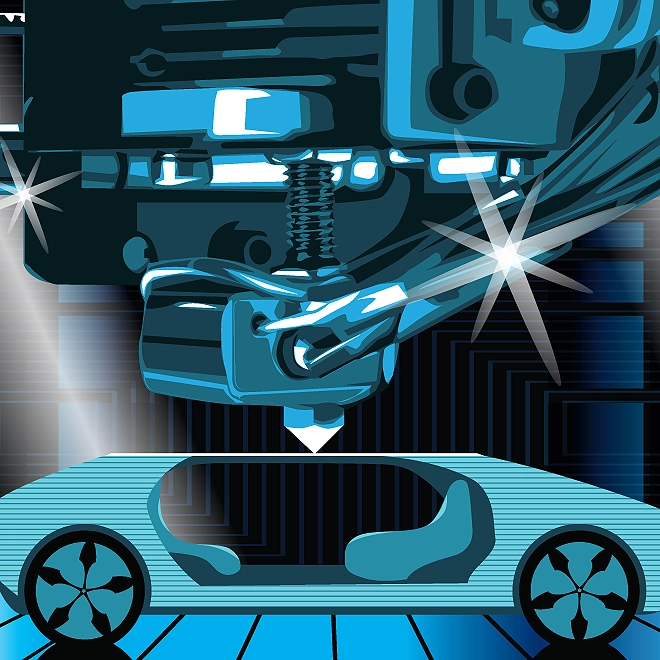Steering into Industry 4.0 in the automotive sector
Taking advantage of uncertain times to align for future success
To remain relevant in the Industry 4.0 ecosystem, automotive companies have to clear some near-term hurdles and have an integrated organizational approach toward technology and innovation.
OVER the past 50 years, the automotive sector has invested billions of dollars in enterprise systems, automation solutions, and advanced product technologies. Nonetheless, in some aspects, automotive companies remain a slow follower to data and technology companies that are defining the competitive landscape of the Fourth Industrial Revolution—Industry 4.0. These technology companies have developed low-cost computing, high-speed connectivity, and machine learning that have enabled the digitization of the physical world, transforming insights into optimized actions. Now, these well-capitalized tech players are entering the automotive sector, and traditional automakers—saddled with legacy infrastructures and product portfolios—are struggling to keep pace.
Technologies causing wholesale transformation of the global automotive sector are commonly called the CASE (connectivity, autonomy, shared mobility, and electrification) technologies. While each technology has started to affect the sector in many ways, their convergence, in the backdrop of looming macroeconomic headwinds, will likely have a tectonic impact on the global automotive value chain. It also means that over the next two decades, it is entirely plausible that some undercapitalized global original equipment manufacturers (OEMs) will fall behind the technology innovation curve. These players could be swallowed by larger players or simply close their doors. Suppliers won’t have it any easier as they’ve taken on more and more of the responsibility to innovate. In fact, suppliers with product portfolios tied to traditional technologies currently being disrupted could well find themselves with unmarketable assets and skill sets. Therefore, to remain relevant in the face of rapid technology development, companies across the automotive ecosystem are investing heavily in product and manufacturing process innovation.
Buying the technology to stay relevant …
Automotive players aim to future-proof themselves through strategic partnerships and targeted mergers and acquisitions. Some are looking to competitors for opportunities to shore up gaps in their technology portfolio. Others are harvesting the fertile landscapes of global innovation hubs such as Israel,1 identifying startups to affect meaningful change across the organization. Yet other companies are looking to digital transformation initiatives to drive efficiencies through their manufacturing processes, investing heavily in technology solutions, including smart factories, cobotics, digital supply networks, artificial intelligence, predictive maintenance, and blockchain. Even some of the CASE technologies are causing companies to think carefully about how they manufacture vehicles going forward. For example, vehicle electrification likely entails a simpler manufacturing process.2
However, focusing on these technological solutions in isolation may not be enough as thriving in a new global automotive industry reality will likely require a willingness to reinvent all the aspects of the business, including the product offering, the business model, manufacturing process, and the customer experience. Individual or conditional technological fixes are not an alternative to a long-term technology strategy. Solving individual challenges only partially delivers on the full value proposition of Industry 4.0. It’s only when these digital technologies are combined with an integrated organizational design can they truly lead to transformational gain.
… but technology by itself is not enough
To succeed in the innovation era, automotive companies will likely need to harness a variety of advanced technologies. In the Industry 4.0 ecosystem, the primary enabler is often data that plays out in the form of a digital twin and digital thread. A digital twin is a near-real-time digital duplicate of every physical object—be it raw material, shipping containers, plant tooling, or the work-in-process flowing down the assembly line—or process and helps optimize business performance.3 Separate from the digital twin is the digital thread, which links together all the events experienced throughout the life cycle of a product.
Digital throughput across the entire value chain and life cycle generates tons of data in real time, which when deciphered can be invaluable to a wide variety of stakeholders. Companies that are successful at capturing and analyzing the data and information can unlock exponential growth opportunities to accelerate along the innovation curve. However, this journey isn’t without challenges.
Overcome key challenges
Many of the systems underpinning Industry 4.0 applications are proprietary and can present integration challenges. Peer consortiums, industry associations, and government bodies are all currently working to establish sets of standards, sometimes even competing sets, with no clarity on which will prevail. Interestingly, not all challenges start at the advanced digital technology stage. Individual companies also face a number of fundamental challenges that threaten their ability to even think about embarking on a journey to implement digital solutions.
While lean management principles have been popularized by Japanese automotive manufacturers, not every automotive company has taken full advantage of their potential value. The primary foundation of the lean philosophy is the continuous identification and elimination of nonvalue-added waste through targeted problem-solving and standardized processes. Lean principles can be applied throughout the value chain, from R&D through marketing, and even when thinking about the cost, time, and effort to implement advanced digital solutions.
Manufacturing companies also face a shortage of talent to plan, execute, and maintain new digital systems. The number of engineers trained in handling unstructured data and big-data tools—crucial for the type and scale of data generated by digital twins and digital threads—is gradually increasing, but still falls far short of anticipated demand. The challenge extends to the shop floor as well. In fact, one of our recent studies forecasts a growing shortage of skilled workers over the next decade—up to as many as 2.4 million unfilled jobs between 2018 and 2028, which could put US$2 trillion of economic output at risk.4
Leading automotive companies already have teams experimenting with certain advanced technologies and data. However, these efforts are often hampered by archaic corporate procedures. Removing such obstacles to properly evaluate and scale forward-looking digital pilots is imperative, but it can only be achieved with appropriate sponsorship and governance. In other words, the right approach to transformational change needs to be applied in a holistic manner to realize the maximum value of digital technologies.
Tackling a small problem first is a time-tested way to begin a transformational technology journey. Small successes can serve as proof points, leading to a greater willingness to take a chance on more substantive investments. By starting small and moving quickly, organizations can generate success stories that prove the value and importance of the full transformation. That said, the quickest way of ending any emergent transformation is the company’s inability to articulate its value to management, investors, and employees. As companies officially stand-up transformation programs, the right determinants for success need to be established, tracked, and tied back to the core enterprise value propositions and growth drivers. Finally, as successful pilots are scaled, value attainment should be assessed, and the rollouts modified accordingly.
Key questions companies should be asking
In order to align with the Industry 4.0 paradigm and take advantage of turbulent times in the automotive sector, company boards and senior executives should be considering the following key questions.
Which advanced innovations will impact the auto industry the most over the next decade?
Although it is impossible to exactly predict the future, there are several innovation signposts coming into view that will have a dramatic effect on the industry and a company’s positioning within it. Performing a critical assessment of necessary innovation capabilities and aligning with industry trends should be a top priority for management.
What will future customers demand?
The customer of the future will likely be more technologically demanding and may seek more than just a traditional automotive experience. Taking a step back to refresh your perspective on what customers want would inform critical decisions regarding the right data and infrastructure needed to offer new, digitally enabled services. It could even spur the development of game-changing innovations or new business models.
Do I have the right talent to fulfill future expectations?
Any wholesale Industry 4.0 transformation undertaken will likely force management to rethink the company’s strategy on several issues, including talent acquisition and development. However, identifying the right skill set and hiring the right talent to drive new growth will likely remain a key challenge. Therefore, companies might need to invest to upskill existing employees, but doing so will likely necessitate sustained investment on both internal and external fronts.
How should I fund the investments needed?
As part of an Industry 4.0 capability assessment, management teams will likely identify pools of excess spend that are misaligned to the overall future vision of the company. To be in the best financial position to invest in a wide-ranging digital transformation, an overarching operational fitness program could free up cash while serving as a great test bed to pilot use cases within manufacturing and other high-cost functions. Likewise, boards can explore the divestiture of underperforming assets while market valuations remain high.
Customer and Marketing Strategy
Stakeholder expectations for growth and profitability have increased while the global business environment grows more complex and fluid. In this environment, the influence and agenda of marketing executives have expanded, yet their organizational context has not fully caught up—they often have only indirect input on many of the critical customer and marketing-related decisions enterprises need to make. Navigating these tensions is what today's chief marketing officers (CMOs) face.

